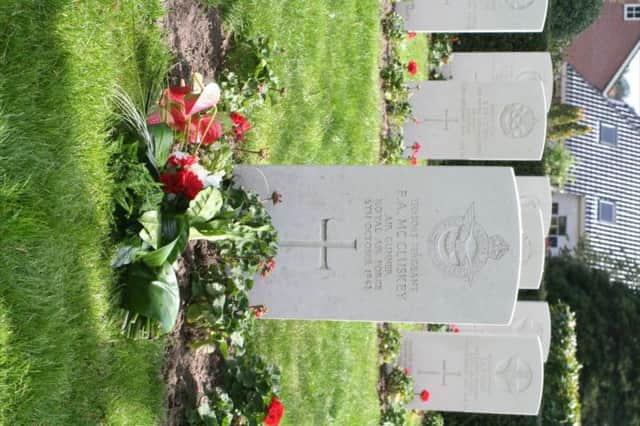Tragic story of forgotten Ballymoney airman


The retired policeman had heard a report that a Royal Air Force (RAF) bomber had crashed nearby.
As they made their way along a country road near the entrance to the estate, they were shocked to see in the distance a parachutist trapped in a tree. The solitary figure was hanging lifeless by the lines of his ripped parachute - sadly, it was clear that the airman was dead. Suddenly, they heard German soldiers approaching.
Advertisement
Hide AdAdvertisement
Hide AdRealising they would be in danger if they were found near the scene, Jan knew they had to leave immediately. At that moment, Jannie noticed a yellow flying cap lying on the ground beneath the airman. Without thinking, she lifted it and put it into her coat pocket, before quickly cycling away behind her father.


When she returned home, Jannie placed the cap carefully in the drawer of her dresser. During the following decades, she kept the cap safely in its place, always hoping that one day she may have the opportunity to meet the family of the tragic airman and return it to them.
Buried at Rhenen
In recent years, the full story of the fallen airman has been gradually discovered by Toon Blokland, a retired officer and veteran of the Royal Dutch Army.
By interviewing locals in Rhenen, Toon learned that after being cut down from the tree by German soldiers, the parachutist was buried in the cemetery at Rhenen. A photograph from 1944 shows a wooden cross to mark his grave: “R.C./M.C.Cluskey/No.1303065/R.A.F./GEVALLEN OP 7 OCT 42 TE RHENEN”. In the background are several similar crosses from Allied servicemen killed during Operation Market Garden, a steel helmet neatly resting in front of each cross.
Advertisement
Hide AdAdvertisement
Hide Ad

A few years later, when the Commonwealth War Graves Commission replaced the wooden cross, at last, the correct name was added to the fine Portland limestone on the grave: Flight Sergeant Francis Anthony McCluskey.
McCluskey was an air gunner on a Halifax MkII of 405 Squadron which took off from RAF Topcliffee, Yorkshire on 6 October 1942. The mission was to follow a flight plan across the Netherlands and bomb Osnabrook in Germany.
At around midnight, the bomber was intercepted by a German nightfighter over Rhenen, Utrecht, and the crew were forced to bail out. McCluskey’s parachute failed to open. The other six members of the crew landed safely in their parachutes but were later captured and spent the next few years as Prisoners of War.
One of the most important breakthroughs in Toon’s research was to find Jannie, now an elderly lady. With the assistance of the RAF, Toon also established that Flight Sergeant McCluskey was born in Ballymoney on 1 July 1922 and that, unfortunately, he had been overlooked in the roll of honour on the Ballymoney War Memorial.
Advertisement
Hide AdAdvertisement
Hide AdWith the support of Ballymoney Museum, Joe Donaghy and the Causeway Branch of the RAF Association and the Ballymoney Branch of the Royal British Legion, this hero will soon be honoured in his home town.
In a ceremony this Saturday, 1 November, Flight Sergeant Francis Anthony McCluskey will join the list of other tragic casualties who never returned home.
Among those attending will be the Dutch researcher Toon Blokland and the Mayor of Rhenen, Hans van der Pas.
In a special gesture, Jannie van Beek-Pol, now 87 years old, will be sending the cap she found back in October 1942; it will be permanently displayed in Ballymoney Museum.
Thanks to the work of Toon Blokland, this young airman will at last be remembered in the home town he left over 70 years ago.